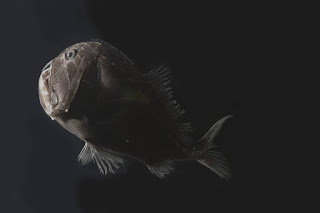Ultra black Skin In Deep Sea Fishes To Escape From Predators
At an ocean depths of greater than 200 m, there is very little ambient sunlight. The bioluminescence animals provide a light source which reveals animals to the predators and prey. But deep in the ocean, the animals exhibit several strategies to hide from the predators: they are transparency, mirrored surfaces, counterillumination, and pigmentation.
The dragonfish might be known as the fangtooth, is a deep-sea fish that wears black to disappear into the darkness. These fish live in the ocean deeps to take a cover. Even they can be caught due to the bioluminescent animals. So they disappear with a trick of their own: the stealth wear.
Scientists reported that the 16 species out of 18 collected exhibit less than 0.5% of reflectance at 480 nm. They exhibit their disappearance through a close layer of melanosomes present within their skin cells. On a microscopic level, the melanosomes present in the ultra-black skin are of different shape and are arranged in geometry.
The specimens were collected via trawl net and a two remotely operated vehicle to lift up black fishes up to a mile deep one in the Gulf of Mexico and the other in the Monterey Bay.
By using various mathematical models, layers having melanosomes with an aspect ratio near 2.0 and SED of 600-800 nm have the lowest reflectance. As the SED increases to >1000 nm the reflectance in the melanosome layer increases.
Getting a decent photo of these species is highly difficult. “It didn’t matter how you set up the camera or lighting -- they just sucked up all the light,” said research zoologist Karen Osborn of the Smithsonian National Museum of Natural History.
Scientists ran a few computer models, simulating fish skin containing different shapes and sizes of melanosomes, and found that ultra-black melanosomes have optical geometry for swallowing light. Making them nearly impossible to pick out in the shadows.




Comments